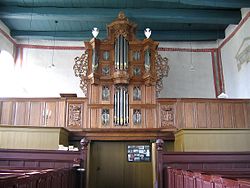Organ of the Dorpskerk Eenum
| Organ of the Dorpskerk Eenum | |
|---|---|

|
|
| General | |
| alternative name | Schnitger organ |
| place | Dorpskerk Eenum |
| Organ builder | Arp Schnitger |
| Construction year | 1704 |
| Last renovation / restoration | 1987 Orgelmakerij Reil |
| epoch | Baroque |
| Organ landscape | Netherlands |
| Technical specifications | |
| Number of registers | 10 |
| Number of rows of pipes | 14th |
| Number of manuals | 1 |
| Tone tract | Mechanically |
| Register action | Mechanically |
The organ of the Dorpskerk Eenum in the municipality of Loppersum in the Dutch province of Groningen was built by Arp Schnitger in 1704 . It has ten registers on one manual and has an attached pedal . The substation is built as a dummy in the gallery parapet and gives the small organ a more representative appearance. The case, prospectus and five stops are entirely original and two are partially original, making the organ one of the best preserved Schnitger organs. It is similar to the instruments in Blankenhagen (1687), Harkstede (1696) and Godlinze (1704).
Building history
New building by Schnitger in 1704
Schnitger built a new parapet organ for the Eenum church in 1703/1704. The oak case was made by Allert Meijer from Groningen. The instrument is backplayed and originally had no pedal, as the bellows was probably built into the lower case.
The substructure is surrounded by two coats of arms carved by Reindt Alberda and Johanna Horenken, who held the right of patronage . The coat of arms on the left bears the inscription "HOC ORGANUM CURA NOBILISSIMI VIRI IN ENUM TOPARCHAE REINDT ALBERDA HOVETMANNI", the coat of arms on the right the words: "EISQUE GENEROSISSIMAE UXORIS IOHANNAE HORENKEN IN DEI GLORIAM FACTO ANNO 1704". The structure of the prospectus is based on the organ of the Blankenhagen village church , which was originally located in the Reformed church in Altona. The top and bottom have the same width. The lower part in the parapet is three-part and flat. The middle field is flanked by two two-story flat fields. They are divided by a profiled transom that runs through the fillings on the outside. The resounding manual work in the upper part is structured in five axes and has an elevated, polygonal central tower and two pointed side towers. Between the towers, two-story flat fields, analogous to the lower part, mediate. 41 of the 108 prospectus pipes are blind pipes. All pipes fields include top and bottom with veil work from. The upper and lower cornices of the manual work are richly profiled. The side wings and the carving next to the central tower show openwork acanthus tendrils .
Later work
Heinrich Hermann Freytag added an attached pedal in 1809 and created two new wedge bellows on the gallery.
In 1845, Petrus van Oeckelen completely expanded the short octave and widened the instrument for the additional tones C sharp, D flat, F sharp and G sharp, which were on an additional drawer. In this course, the side wings and cornices were changed. The side towers were crowned with vases in the style of neoclassicism . Van Oeckelen removed the Woudfluyt, both fifths, sesquialter and Scherp and created the new registers Praestant 8 ′ (from g) and Bourdon 16 ′ (treble) from Woudfluyt and Quint 3 ′ . The organ now had eight stops. In 1891 Jan Doornbos replaced Freytag's bellows with a magazine bellows.
restoration
The instruments by Eenum and Godlinze were both brought to the workshop of Orgelmakerij Reil in 1983 and restored at the same time. Reil removed the side extensions and restored the case, wind chests, action and keyboards. The bass notes of the pedal C sharp, D flat, F sharp and G sharp were coupled an octave higher. The workshop reconstructed the condition from 1809 including the magazine bellows from 1891. It restored the original disposition including the short octave. The side wings were swapped and rotated 180 degrees. The oak casing has been freed from secondary layers of paint and has regained its wood-like appearance. The labia were gilded and the crowning vases were painted white.
Disposition since 1987 (= 1704)
|
|
|||||||||||||||||||||||||||||||||||||||
- Tremulant (R), windless
- Remarks
- S = Schnitger (1704)
- Fri = Friday (1809)
- R = Reil (1987)
Technical specifications
- 10 registers, 14 rows of pipes.
-
Wind supply : magazine bellows (Doornbos)
- Wind pressure: 66 mm water column
- Wind chest (Schnitger)
- Action:
- Keyboards: Manual (Schnitger), Pedal (Freytag)
- Tone action: mechanical
- Stop action: mechanical
-
Mood :
- Modifies the mean tone tuning
- Pitch: a semitone over a 1 = 440 Hz
literature
- Cornelius H. Edskes , Harald Vogel : Arp Schnitger and his work (= 241st publication by the Society of Organ Friends ). 2nd Edition. Hauschild, Bremen 2013, ISBN 978-3-89757-525-7 , pp. 96 f, 182 .
- Gustav Fock : Arp Schnitger and his school. A contribution to the history of organ building in the North and Baltic Sea coast areas . Bärenreiter, Kassel 1974, ISBN 3-7618-0261-7 , p. 243 .
Web links
- Arp Schnitger organ database
- Arp Schnitger organs (English)
- Page by H.-W. Coordes
- Organ database
- Discography striving for completeness
Individual evidence
- ↑ Disposition with Nicolaas Arnoldi Knock: Dispositien der Merkwaardigste Kerk-Orgelen . Petrus Doekema, Groningen 1788, p. 47 ( limited preview in Google Book search).
- ↑ Edskes, Vogel: Arp Schnitger and his work. 2nd edition 2013, p. 182.
- ^ Stef Tuinstra : Orgel in Eenum (Dutch), accessed on March 2, 2018.
- ↑ a b Edskes, Vogel: Arp Schnitger and his work. 2nd edition 2013, p. 96.
- ↑ Fock: Arp Schnitger and his school. 1974, p. 243.
Coordinates: 53 ° 20 ′ 22.6 " N , 6 ° 46 ′ 45.6" E

